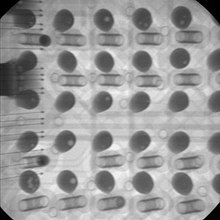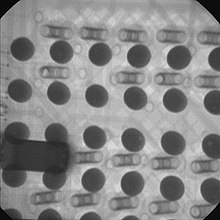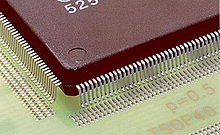Rework
Rework is a term which rework or repair of electronic assemblies ( English printed circuit board assembly , PCBA) in the surface assembly designated. The various work processes usually require technically complex machines and specific know-how from trained employees.
Reasons for the rework
Various test methods are used in assembly production. These include, for example, the visual inspection by production employees, the ( automatic optical inspection ) (AOI), the automatic X-ray inspection, the in-circuit test, the functional test and the high-voltage test.
If a test procedure reveals a missing or bad soldered connection, a missing, incorrectly placed, twisted or defective component or a missing or defective circuit function, the assembly is reworked, insofar as this makes economic sense. In this case, the rework can include the re-soldering of a soldering point or the replacement of components.
The rework is also used in the area of after-sales repairs (e.g. warranty repairs). The focus here is on repairing the assembly or the device.
In the course of a research or development project, components can be removed, exchanged or additionally equipped with a rework.
Work steps of the repair process
A repair process for surface-mounted components (English surface-mounted device , abbreviated to SMD) usually consists of the following steps:
- From soldering the defective component
- Remove the remaining solder on the circuit board (and possibly on the component)
- Application of new solder paste to the circuit board or the component (possibly reballing or paste printing)
- Pick up, align, and place the component
- Solder in the new component
When carrying out repairs, care must be taken that surrounding components are not melted and misplaced. In the practice of IR soldering , this is done by sticking protective films on, which must be checked at each work step and, if necessary, repositioned. Hot gas repair stations offer this security through the design of the soldering nozzle and the settings of the soldering profile. A soldering profile optimized for the printed circuit board also contributes to safety. Systems that provide intelligent heating for top and bottom heat are the first choice here. Any unnecessary thermal load on the assembly leads to premature aging and should be avoided if possible. Both the time and the temperatures are to be kept as low as required by the specifications of the component manufacturer in order not to damage the component.
Value chain
When a single surface-mounted component is unsoldered from the electronic assembly (PCBA), all soldered connections between these two parts are melted and the components are separated from one another.
The old solder is then removed from the array (grid) on the circuit board. By re-heating until it reaches the melting point, it is relatively easy to remove any remnants of the loosened solder joints. In order to avoid damage to the circuit board, care should be taken to remove the remaining solder without contact. Furthermore, it must be ensured that this process is kept as short as possible in order not to unnecessarily put thermal stress on the circuit board.
For the exact positioning of the new SMD on the prepared pad array, the specialist needs a rework station, which, due to the optical resolution, is able to bring the ball of the SMD as precisely as possible into alignment with the contact surfaces of the circuit board. The smaller the pitch of the components, the higher the demands on the rework station. Due to the changed properties of the solder due to the introduction of lead-free solders, the placement accuracy of the system should be 10 µm or higher. An automatic device is not a mandatory requirement for precise placement; only the stability of the system and the optical resolution determine the accuracy.
Finally, solder the SMD you just placed onto the circuit board. In order to create reliable and high-quality soldered connections, all soldered joints between the new component and the PCBA with the appropriate soldering profile are heated above the melting point and then properly cooled.
Additional aspects
The value chain for rework described above can be supplemented by special processes.
High quality requirements or special designs of the SMDs make the application of solder paste prior to placement u. U. inevitable. For example, components are delivered in the Quad Flat No Leads Package (QFN / MLF) or in the Quad Flat Package (QFP) without a solder depot. A solution for applying fresh solder paste must be found. There are two options for this:
- Application of solder paste to the circuit board (e.g. QFP)
- Application of solder paste directly onto the component (e.g. QFN / MLF)
For the simple application of solder paste during repairs, we recommend solder paste printing using a printing template and squeegee. This method can be carried out simply, quickly and with great accuracy. It is crucial that the same amount of solder as during manufacture is applied to the contact surfaces. Another, albeit technologically more complex, variant is the dispensing of solder paste.
Sometimes the unsoldered BGA or CSP can be reused. In this case, the component must be freed from residual solder. As with the printed circuit board, contactless processes are preferred here in order to protect the component from damage. It is currently already possible to clean the contact surfaces of a BGA 35 × 35 in one step without contact. The new balls are applied to the component using a reballing module, which also works with templates. The template is positioned exactly on the BGA and then equipped with solder balls. During the reflow process, an inert atmosphere - like in a reflow oven - should be ensured to improve the result.
Application in industry
Professional and high quality rework restores the correct functioning of the electronic assemblies. Once the rework value chain has been carried out correctly, the life of the assembled circuit board is hardly affected. This is why rework is widespread in all areas of the electronics industry. Users include manufacturers of telecommunications technology, entertainment and household appliances, industrial goods, automobiles, medical technology, aerospace and other high-performance electronics, as well as their service providers.
literature
- Reinard J. Klein Wassink: Soft soldering in electronics . 2nd Edition. Eugen G. Leuze, Saulgau 1991, ISBN 3-87480-066-0 .
- Wolfgang Scheel (Hrsg.): Assembly technology of electronics . Verlag Technik et al., Berlin et al. 1997, ISBN 3-341-01100-5 .






